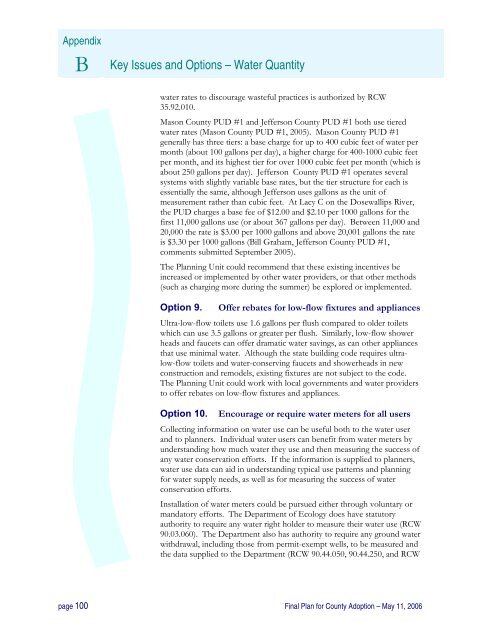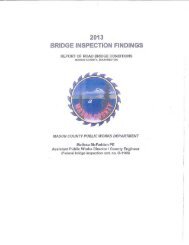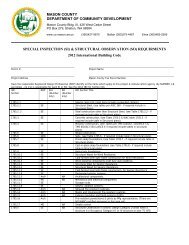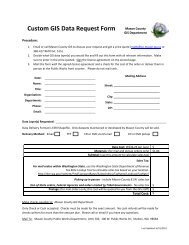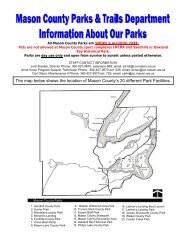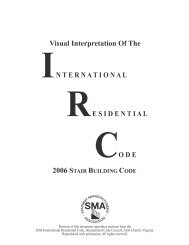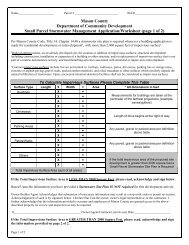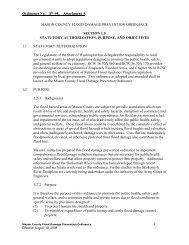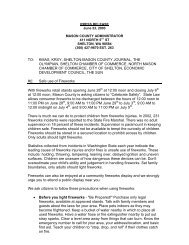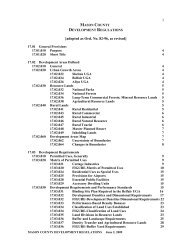Watershed Management Plan - Mason County
Watershed Management Plan - Mason County
Watershed Management Plan - Mason County
You also want an ePaper? Increase the reach of your titles
YUMPU automatically turns print PDFs into web optimized ePapers that Google loves.
Appendix<br />
B Key Issues and Options – Water Quantity<br />
water rates to discourage wasteful practices is authorized by RCW<br />
35.92.010.<br />
<strong>Mason</strong> <strong>County</strong> PUD #1 and Jefferson <strong>County</strong> PUD #1 both use tiered<br />
water rates (<strong>Mason</strong> <strong>County</strong> PUD #1, 2005). <strong>Mason</strong> <strong>County</strong> PUD #1<br />
generally has three tiers: a base charge for up to 400 cubic feet of water per<br />
month (about 100 gallons per day), a higher charge for 400-1000 cubic feet<br />
per month, and its highest tier for over 1000 cubic feet per month (which is<br />
about 250 gallons per day). Jefferson <strong>County</strong> PUD #1 operates several<br />
systems with slightly variable base rates, but the tier structure for each is<br />
essentially the same, although Jefferson uses gallons as the unit of<br />
measurement rather than cubic feet. At Lacy C on the Dosewallips River,<br />
the PUD charges a base fee of $12.00 and $2.10 per 1000 gallons for the<br />
first 11,000 gallons use (or about 367 gallons per day). Between 11,000 and<br />
20,000 the rate is $3.00 per 1000 gallons and above 20,001 gallons the rate<br />
is $3.30 per 1000 gallons (Bill Graham, Jefferson <strong>County</strong> PUD #1,<br />
comments submitted September 2005).<br />
The <strong>Plan</strong>ning Unit could recommend that these existing incentives be<br />
increased or implemented by other water providers, or that other methods<br />
(such as charging more during the summer) be explored or implemented.<br />
Option 9.<br />
Offer rebates for low-flow fixtures and appliances<br />
Ultra-low-flow toilets use 1.6 gallons per flush compared to older toilets<br />
which can use 3.5 gallons or greater per flush. Similarly, low-flow shower<br />
heads and faucets can offer dramatic water savings, as can other appliances<br />
that use minimal water. Although the state building code requires ultralow-flow<br />
toilets and water-conserving faucets and showerheads in new<br />
construction and remodels, existing fixtures are not subject to the code.<br />
The <strong>Plan</strong>ning Unit could work with local governments and water providers<br />
to offer rebates on low-flow fixtures and appliances.<br />
Option 10.<br />
Encourage or require water meters for all users<br />
Collecting information on water use can be useful both to the water user<br />
and to planners. Individual water users can benefit from water meters by<br />
understanding how much water they use and then measuring the success of<br />
any water conservation efforts. If the information is supplied to planners,<br />
water use data can aid in understanding typical use patterns and planning<br />
for water supply needs, as well as for measuring the success of water<br />
conservation efforts.<br />
Installation of water meters could be pursued either through voluntary or<br />
mandatory efforts. The Department of Ecology does have statutory<br />
authority to require any water right holder to measure their water use (RCW<br />
90.03.060). The Department also has authority to require any ground water<br />
withdrawal, including those from permit-exempt wells, to be measured and<br />
the data supplied to the Department (RCW 90.44.050, 90.44.250, and RCW<br />
page 100 Final <strong>Plan</strong> for <strong>County</strong> Adoption – May 11, 2006


